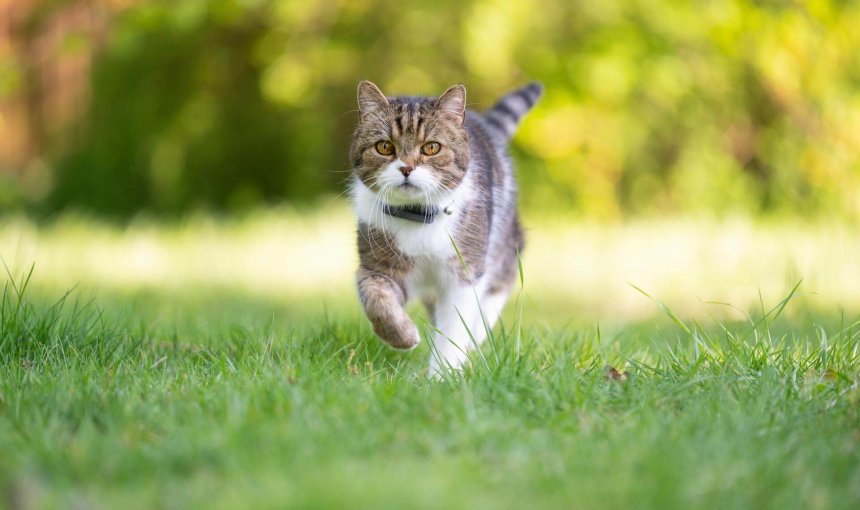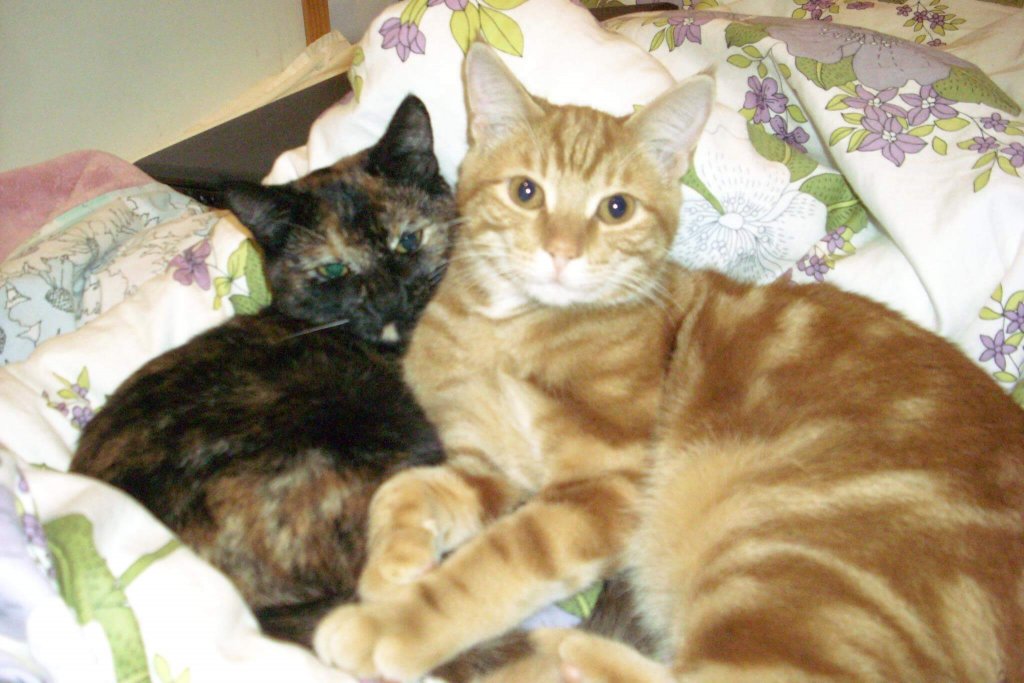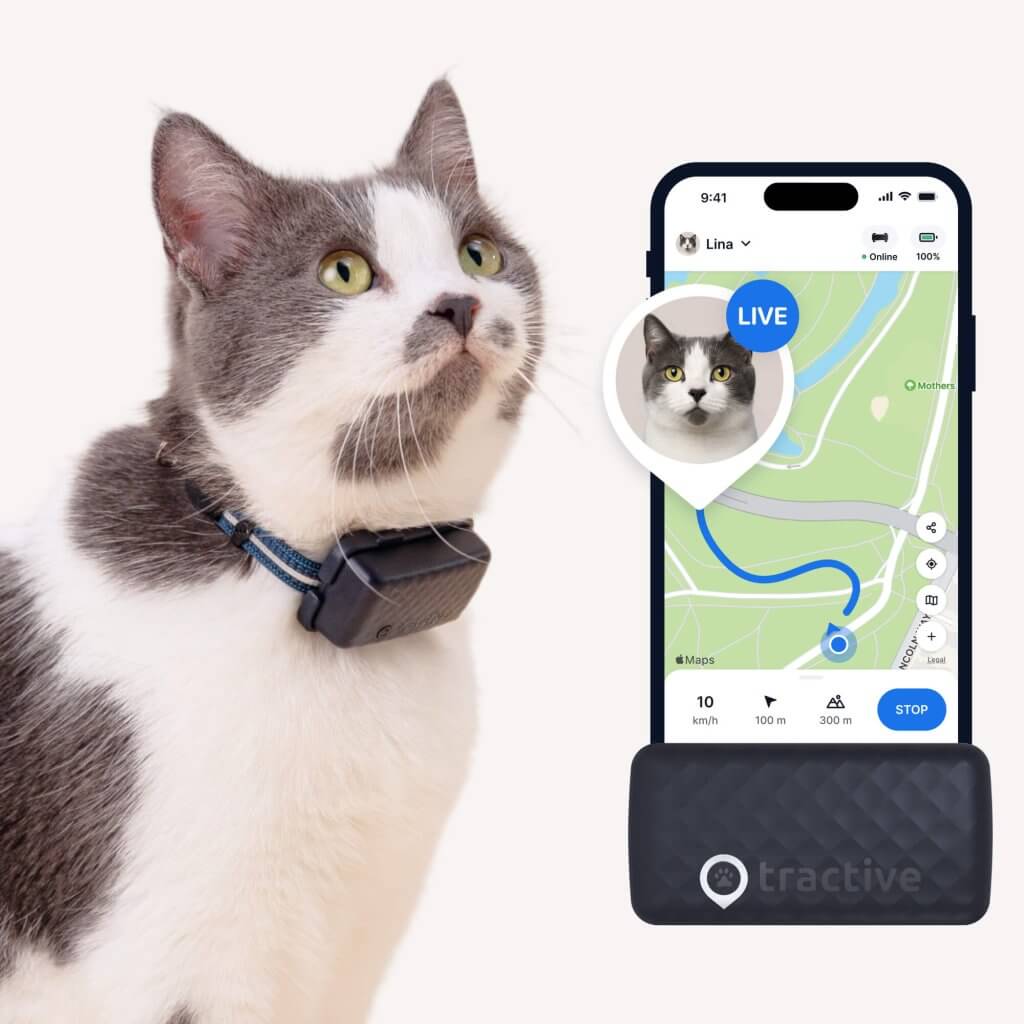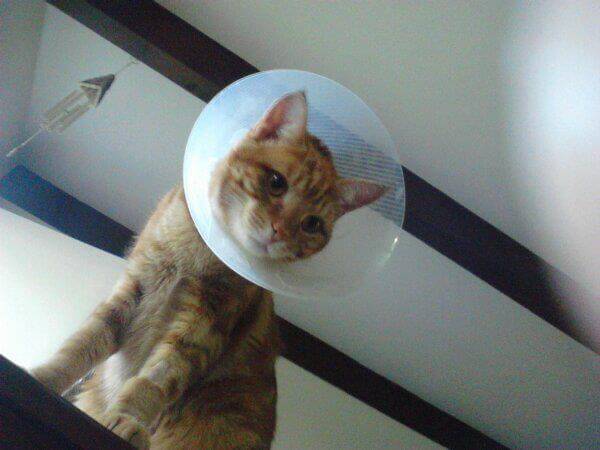 Approved by Dr. Dwight Alleyne, DVM
Approved by Dr. Dwight Alleyne, DVM Is Your Cat In Heat? Here’s What You Need To Know.
Cat in heat? Uh oh! Follow our tips to be prepared for your cat's mating behavior and know what you can do to best help your feline friend.

A few years ago, I had the pleasure of raising two adorable baby kittens from infancy – we fed them with a bottle and helped them grow into big healthy, teenage cats. But at some point, my young cats started acting funny; and I soon realized it was because they had reached the age of sexual maturity. Hello, cat in heat! But what to do when you are presented with this funny behavior, and the new mating rituals of your feline furry friend? How do you recognize the signs of a cat in heat? And how to best handle a cat in heat (especially if you want to prevent an unwanted cat pregnancy)? We’ll cover all that and more, in the article below. Plus, discover the best way to keep track of your cat at all times.
Key Takeaways
- ‘Heat’ refers to when an intact female cat can become pregnant and have kittens.
- Cats usually go into heat for the first time anywhere around 3-18 months old – already as kittens.
- Cats in heat are often more affectionate and restless, and may eat less and vocalize more than usual. They might also urinate more frequently or try to run away.
- Unless you plan to breed your cat, it’s best to spay your cat in heat.

Find out where your cat spends their time.
Read more- What does it mean when a cat is in heat?
- Can male cats go into heat?
- Cat in heat signs & symptoms
- Do female cats have periods?
- The cat heat cycle explained
- How long are cats in heat?
- How often do cats go into heat?
- Are cats in pain when they’re in heat?
- How to calm a cat in heat
- Can you spay a cat in heat?
- How to prevent unwanted pregnancy in cats
- Conclusion
What does it mean when a cat is in heat?
You might have heard the term, ‘cat in heat’ or ‘dog in heat‘ before. ‘In heat’ refers to when a female cat is ready to mate (have sex) and fertile (can become pregnant). This is also known as the oestrus phase of her sexual cycle and begins already at the age of 5 to 10 months old. (Remember, cats age faster than humans).
The first time I ever realized my young cats were in heat was when they seemed to attempt to mate with each other – although they were brother and sister. 😨

Yes, this can and does occur; especially among cats who are not exposed to many other cats in the wild. While in heat, their strong, natural mating instinct will cause them to try to mate with any and every cat of the opposite sex nearby – the cat in heat does not obey any rules about how humans think they ‘should’ behave!
Get your cats spayed and neutered to avoid unwanted cat pregnancies.
Can male cats go into heat?
No, male cats don’t go into heat. Only female cats go into heat. Unneutered, however, male cats reach sexual maturity around the same time as female cats – around four to six months of age. At this time your male cat may start urine marking their territory or running away in search of a mate. In these cases, a GPS cat tracker can be a lifesaver.
To successfully handle a feline in heat, it’s good to know the signs of a cat in heat.
Cat in heat signs & symptoms
So how to tell if a cat is in heat? Be aware of the following cat in heat signs and symptoms that your cat might display if they are in heat. Your cat might:
- start making funny sounds
- become more restless
- crawl low to the ground
- be more affectionate with people, objects, and other animals
- groom their private parts more frequently
- try to escape outdoors
- assume the mating position (behind in the air, tail to the side)
- urinate to mark territory
- lose appetite
So whether your unspayed cat is meowing, moaning, or crying, walking funny, rubbing up against you and furniture in your home, or taking extra special care of her lady parts, if your cat displays one or more of these signs, you most likely have a cat in heat on your hands. Now, let’s take a look at feline periods and the heat cycle in cats.
Do female cats have periods?
Female cats do have a monthly cycle, but one which is quite different from female humans. Rather than shedding the uterine lining like human women do every 32 days or so, cats and select mammals reabsorb the old uterine-lining rather than bleeding it out. This takes place during the estrus cycle described below.
A small amount of blood may be shed during the heat cycle of your cat but it is more common for a female cat with a ‘period’ to display the signs of a cat in heat above. Contact your vet if you notice worrisome bleeding in your female or male cat.
The cat heat cycle explained
All female cats will go through the natural heat cycle unless they have been spayed or are pregnant. This is also referred to as the estrus cycle and during this time, a cat is capable of breeding – that is, mating and having kittens. The stages of the cat in heat cycle are described in detail below:
Proestrus
In this stage, the female cat (known as the queen 👑) might attract male cats (that are unneutered). However, she will not be ready for mating yet. In this stage, which lasts 1-2 days, cats do not show any typical signs of being in heat.
Estrus (heat)
Next, the unspayed female cat enters the heat stage, also known as estrus, oestrus or estrous. For up to a week, she will be receptive to mating and attract the attention of male cats. This is also when she will display the signs of heat. In case things get hot and heavy, hormone production will be stimulated, which leads to ovulation. Cats may mate several different times during this stage before becoming pregnant. When a female cat does become pregnant, her kittens can have different fathers.
😻 During the estrus phase, female cats in heat will be open for mating – so be sure to follow our recommendations below to ensure you handle your kitty in heat with care and caution.
Watch out – your female cat may roam when in heat, looking for her next mate! Male cats also have a tendency to explore their grounds, looking for females in heat. You can monitor your cat’s whereabouts during this time with the help of cat GPS and health tracker.

Track your cat wherever they go
See where they are in real-time, no matter how far they roam. Discover their territory. Get alerted if they go too far. Track activity, sleep, and receive health alerts if your cat’s activity changes. Keep your feline friend healthy and safe.
Interestrus
In case the cat has not mated or become pregnant during estrus, she will enter the phase of interestrus, or the period between heats. She will display no specific signs of being in heat. In a few days or up to 3 weeks, the cat will go into heat again. The cycle of proestrus, estrus, and interestrus repeats throughout the mating season.
Anestrus
The last stage is called anestrus – this is a dormant period for the cat’s reproductive system. She will not experience any estrus activity, as mating season is often seasonal. The heat cycle tends to last from spring to fall, when the light of long days stimulate your feline’s hormones. During the shorter-day seasons of late fall and winter, your cat may not go into heat at all. However, artificial lighting may cause your cat to go into heat all year.
If you notice unusual behavior in your cat, and aren’t sure if she’s in heat or not, contact your vet for support.
How long are cats in heat?
The cat in heat or estrus phase – when the cat is ‘calling’ for a prospective mate – can last anywhere from 1 – 7 days. If the cat does not mate, she will likely go into heat again a few weeks later. The whole cycle lasts about 3 weeks, according to Pippa Elliott, MRCVS Veternarian¹, and may continue year round or only from February – October.
How often do cats go into heat?
As long as a female cat is not spayed, she may go into heat as often as every two to three weeks. Cats can have multiple heat cycles during their breeding season, which is generally during the warmer months. However since most cats in North America and Europe live indoors in comfortable environments, they can come into heat year round2.
Are cats in pain when they’re in heat?
The cat heat cycle is a normal and healthy part of the life of every cat. Being in heat is not typically painful for cats, although they may feel some discomfort or agitation.
When your cat in heat makes a loud, howling sound, you may assume they’re in pain. But rest assured, the increased vocalization (known as “caterwauling”) is just your cat’s way of attracting a potential suitor.
How to calm a cat in heat
If your cat seems excited or agitated, you may want to help calm her while she is in heat. Here are several ideas for how to calm a cat in heat:
- keep your female cat away from male cats
- let her sit on a heat pack, warm towel, or electric pad or blanket
- try catnip
- use Feliway or other synthetic cat pheromones
- keep the litter box clean
- play with your cat
Can you spay a cat in heat?
Once you notice that your female cat is in heat, you may want to get them spayed to prevent future pregnancies. But can you spay a cat in heat? Veterinarians recommend waiting at least one month after your cat’s heat cycle before getting them spayed. That’s because cats that get spayed during heat may experience more bleeding and be more at risk during the surgery than cats that are not in heat.
Additionally it may cost more to have your cat spayed while she’s in heat3. Talk to your vet about when is the best time to spay your feline.
How to prevent unwanted pregnancy in cats

The safest way to avoid unwanted pregnancy in female cats is to have them spayed as soon as they reach sexual maturity. It’s important to get your male cats neutered too, to avoid them causing unwanted pregnancies in your neighborhood queens, a.k.a female cats.
Here is an overview of what you can do to prevent your cat from mating while in heat:
- Get your cat spayed or neutered before or around the time of their first heat cycle.
- Monitor your cat’s whereabouts, activity and health with a smart cat tracker.
- If possible, separate male and female cats in your home while one or more cat is in heat.
- Avoid letting your cat outside if you suspect they are in heat.
- Create a cat enclosure so your cat can be outdoors, but safely protected from other cats
After getting neutered, Beta thankfully no longer tries to mate with his sister – or any other cats around. And thanks to the Tractive GPS cat tracker I can always keep an eye on his whereabouts right in the smartphone app and retrieve him if needed.
Conclusion
Now you have learned the signs of a cat in heat, how long the heat cycle lasts and its different components, how to calm a cat in heat plus how to prevent unwanted cat pregnancy. We learned that cat in heat behavior can start at an early age – around 5 months old – and that it’s safe for cats to be spayed around this time. The top ways to prevent an unwanted pregnancy in your cat include:
- Get your cat spayed or neutered
- Invest in a GPS and health tracker for your cat
This way, your furry friend can calm down from her natural heat cycle, and enjoy exploring her territory while you have peace of mind!
Your furry friend’s health and wellbeing means as much as to us as it does to you. So we’ve made it a priority to only share medically-relevant content on our blog. This post was checked, double-checked, and medically verified by Georgia-based vet, Dr. Dwight Alleyne.

Dr. Dwight Alleyne, DVM
Originally from Long Island, New York, Dr. Alleyne began his career at a no-kill animal shelter before becoming a licensed veterinary technician. He graduated from Cornell University Veterinary College in 2006 and completed an internship at Purdue University. Now practicing in Georgia, Dr. Alleyne specializes in soft tissue surgery and ultrasounds. He also writes pet health articles on his website, “The Animal Doctor Blog” (www.anmldrblog.com).




